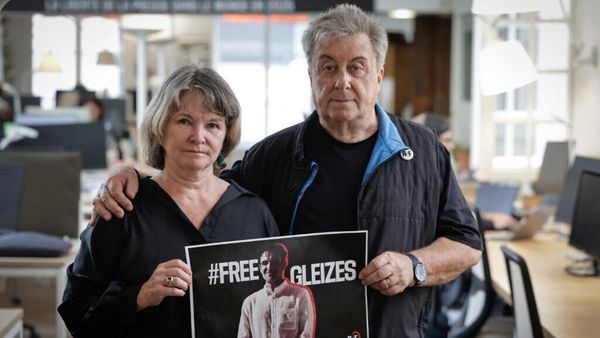
Two big blokes thunder towards each other. One tucks in for a tackle, his solid shoulder connecting with his opponent, just under his chin.
His opponent goes down, his heavy limbs flopping to the ground.
He doesn’t get back up.
The MC tries to hold back the Campbelltown crowd – many of them small children – to let the medics through.
This is the Run It Straight challenge, a brutal new competition and – thanks to social media – a deadly new craze. From a rugby-inspired back yard game, it’s become an organised activity with thousands of dollars in prize money. And millions of views online.
Even as more is discovered about concussions, the long-term effects such as cognitive impairment and the neurodegenerative disease chronic traumatic encephalopathy (CTE), Run It Straight is soaring in popularity.
Each violent encounter – just 30 seconds or so – is tailor-made for social media.
“We’ve got guys running at each other [with enough force] to cause a brain injury,” concussion expert and neuroscientist Alan Pearce says.
“They are supercharging and exploiting the most violent aspects of the tackle in rugby league, and turning up the dial.”
It may have originally come from something kids from the Pacific Island diaspora did, a back yard lark. But now it’s organised, with at least two Australian groups running competitions in New Zealand and Australia, their social media posts running hot.
There is the “official” Run It Straight group, which was established in 2024.
That’s the one that posted that Campbelltown event, describing it as a “war zone”. “Campbelltown didn’t hold back – four knockouts, heavy hits, and bodies dropping left, right and centre,” the YouTube caption said.
“Full contact. No headgear. No mercy.”
Then there’s the much slicker RUNIT Championship League, which was registered in February.
“RUNIT is the world’s fiercest, new collision sport,” the website boasts. “Born to go viral, built to break limits, it has taken social media by storm with tens of millions of views.
“One runner. One tackler, A 20m x 4m battlefield. Victory belongs to the one who dominates the collision.”
Now amateurs are giving it a go. At a recent Manly Sea Eagles match, fans filmed a guy chugging a beer before pelting down a hill into another guy.
And on Tuesday, a New Zealand teenager died from a head injury after playing a tackle game with friends that police said was “based on a social media-driven trend, where participants compete in full-contact collisions without protective gear”, a trend NZ media said was the Run It Straight challenge.
Pearce, a Swinburne University professor, says he is genuinely stressed witnessing the collisions.
“We know two things,” he says.
“One is that that there are longer term outcomes in terms of cognitive impairment … for those exposed to a lot of impact to the brain, the risk and severity of CTE is greater.
“And, from a younger person’s perspective, the concern is around second impact syndrome. If a younger person has an injury but doesn’t understand they’ve got a concussion and then a second later they get a second impact, that’s catastrophic.”
Pearce says it’s like watching a “car crash in action” with participants potentially experiencing more than 100Gs of force.
RUNIT said the teenager’s death was “tragic” and that contact sports should only be held in “highly controlled environments, which include professional medical supervision and support”.
RUNIT did not respond to an interview request.
On their Instagram page, RUNIT writes that “safety is paramount”.
“We are committed to the health, safety, and wellbeing of every athlete who represents our brand,” the post says.
“We recognise that competing at the highest level comes with physical risks, and we firmly believe that no athlete should bear the burden of those risks alone.”
RUNIT covers all medical expenses “directly related to injuries sustained while competing”, it says, and compensates them for any wages lost.
Run It Straight 24 organiser, Christian Lesa, told Triple J’s Hack program this week the tackling game had been happening for “ages”, that people do it at church events, at family gatherings. “A lot of the boys do it when they get on the piss,” he said. He went on to outline the rules – nothing above the collarbone, and if you get “dazed” or hit on the head, you’re out.
“We have paramedics and ambulance on standby … just in case anything happens,” he said, adding that for future events they’ll have headgear and mouth guards, “to make sure that everyone does participate with us safely, in the safest way possible”.
Elizabeth Summerell, a psychologist and lecturer at the University of Adelaide specialising in anger and aggression, says the trend could reflect “deeper social and cultural pressures tied to masculinity”.
She points to research that found younger Australians are more likely endorse “traditional masculine norms like physical toughness, dominance, risk-taking, and status seeking”.
As well as “performing this masculinity”, she says, there is a strong pressure to conform in order to be liked, to avoid looking weak, to reinforce their group membership and gain status.
“So even though the risks may be obvious, the social rewards, like status and belonging, may be more powerful than the threat of injury,” she says.
“And for young people who may be sensitive to approval from their peers, social media may amplify these processes further. Social media platforms don’t just serve to document these acts, but likes and shares become a kind of social currency.
“In this way, social media is not just reflecting the trend but also fuelling it.”
Pearce wonders whether it appeals to “the most primitive parts of our brains that feed off violence”.
“All I can do is be a grumpy neuroscientist that says ‘just don’t do it’.”
Back at the Campbelltown game, the MC takes a break from revving up the crowd to speak about someone with mental health issues who died.
“To you young ones,” he says, “make sure you look after yourselves.”







